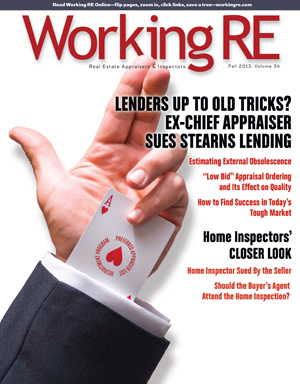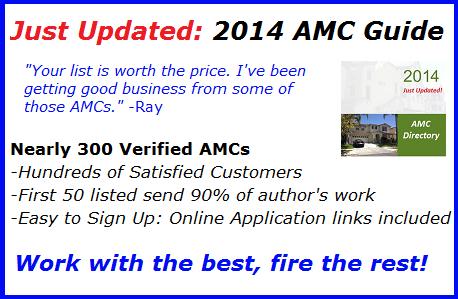 |
>> See Past News Editions >> Click to Print >> Upcoming Webinars: (recorded versions available) – Tomorrow: Feb 13th: There’s WHAT in Your Workfile? – Mar 11th: Fannie Mae’s New Appraisal Quality Monitor (AQM) – Impact on Appraisers >> Slow? Get Busy: Work directly with clients, get paid full-fees and diversify your business. Click here to learn more. |
You Only have to Make 700 +/- Decisions in the Next Six Hours
by Diana Jacobs
It’s a curious time in which the appraiser finds themselves practicing.
There is greater oversight with demands for shorter turnaround time. There are appraisal management companies (AMCs) that shop the appraiser’s turnaround time and price.
There are software companies that download data the appraiser enters with graphs, market conditions analysis, regression analysis and a wide variety of maps and pictures, which makes it appear as though the appraiser has chartered a plane, shot an aerial view, contacted governmental agencies and obtained tax information, flood information, environmental information, a soils survey, zoning and of course, provided a complete breakdown of the current Multiple Listing Data.
All of this information is at the very finger tips appraisers, who are being encouraged to consider, in the future, having someone else do their inspection while they work with the data from their desktop. The trend among users and providers is to have the appraiser focus on their “critical thinking” time. So just how much time is involved in an appraisal and how many decisions does an appraiser have to make?
(story continues below)

(story continues)
Using the form 1004 residential form (most widely used form for a large majority of lending practice) the appraiser has numerous decisions to make in roughly six to eight hours.
It breaks down like this:
Page 1 206 decisions (134 without the condition and individual blocks of choice)
Page 2 205 decisions (potential blanks to be completed)
Page 3 41 decisions (narrative blanks for the possible additional comments)
1004MC 71 decisions/blanks to complete
Total 523 possible decisions (451 without condition of materials and blocks of choice)
All of these decisions are without directions on what the appraiser must do when inspecting the neighborhood and the subject and the comparative transactions or the Limiting Conditions or the 25 Ethical Obligations of the Signed Certification Page, which at a minimum, has to have an additional item #26 for the history of service disclosure.
Keep in mind, you have to plan your inspection and never leave a neighborhood the same way you came in. Why? Because you stated you inspected the neighborhood: how did you do that if you didn’t drive all of the streets or charter a plane to fly over to ensure everything is the same or similar in terms of maintenance, condition, and general conditions that create and affect the value?
(story continues below)

(story continues)
What’s the running total? 523 Decisions on the form. Twenty-six (26) Ethical Obligations to promise and be held legally accountable for by up to 30 years in prison and a fine of up to $1 million, according to Title 18 U.S. Code Section 1001 or similar state laws.
Whew! Now it’s time, of course, to consider the remaining decisions;
· 3 Directives of USPAP SR 2-1
· 12 Directives of the Written Report in SR 2-2 (a) of the 2014-2015 USPAP Appraisal Report
· 10 Directives of SR 2-3 but we aren’t going to count those 10 as they are part of the 26 on the Supplemented Form.
There are four USPAP Rules and each has very specific decisions and directives which appraisers are required to prove they have taken into consideration and/or performed. The Ethics Rule has three subsections; the Record Keeping Rule includes nine items of musts. The Competency Rule has three directives on being competent; three directives on acquiring competency and three directives on what to do if you discover you’re not competent. The Scope of Work and Jurisdictional Exception rules both have multiple directives of exhortations and prohibitions (do’s and must not do’s).
We’re not through yet. Mortgage lending comes with a host of additional decisions which result in approximately 130 pages of assignment conditions of which about 40 pages relate to the residential appraisal report form and each page adds its own specific directive on the additional requirement of performing and reporting an appraisal in the secondary market. There are easily 100-200 additional considerations that must be made under those assignment conditions.
Oh, lest we forget, 67 of those fields of the 1004 form must be UAD compliant.
(story continues below)
(story continues)
784 Decisions to Make, 784 Decisions
My count, and it doesn’t break down the multiple directives of the assignment conditions or specifics of the Statements of USPAP or the Scope of Work Rule, etc., is 784 decisions for the appraiser in every residential assignment.
Don’t get me wrong, I’m all for maintaining quality management and quality control over this most serious issue of performing an appraisal assignment. When an appraiser makes a mistake they should be grateful for the opportunity to correct the error. In the event the error was discovered after the fact, the appraiser needs to accept accountability.
Often the appraiser, in an effort to get the job done in time, will fail to keep the appropriate documentation in their workfile. It’s not always about the intentional act of trying to withhold or mislead. It’s simply a time issue for the appraiser. In the appraiser’s mind if it’s available through Internet research why does it have to be printed out when it can be retrieved if needed? Of course, that has proven to be the Achilles Heel of many state-disciplined appraisers as the workfile is the evidence needed to prove compliance with all of the regulations in those many decisions that have to be made during an assignment.
Now, may I ask you this question? Is the appraiser really getting the respect, support and monetary remuneration for the service they provide? Isn’t it time for the users of the appraisal services to recognize the work that goes into the appraisal product? Shouldn’t the users of appraisal services and the regulators of appraisers recognize the obvious potential for errors when so many decisions have to be made in such a short amount of time? Isn’t that what our forefathers thought when they stated in the development rule of SR 1-1 (c) “Perfection is impossible to attain, and competence does not require perfection”?
About the Author
Diana Jacob currently lives outside Hillsboro, Texas on a small ranch and has been involved in real property appraisal since the latter part of the 1980s. She holds the Certified General Certification from the states of North Carolina, Georgia and Texas and a Residential Certification from the state of Louisiana. She is a certified USPAP instructor and represents the Texas Association of Appraisers at The Appraisal Foundation Advisory Council (TAFAC).
Upcoming Webinars:
February 13th: There’s WHAT in Your Workfile? – Presented by Tim Andersen, MAI, M.Sc., CDEI
New rules are leaving appraisers more exposed than ever to legal and regulatory complaints. Get an expert’s insight into how to bulletproof your workfile from clients, your state appraisal board and others.
March 11th: Fannie Mae’s New Appraisal Quality Monitor (AQM) – Impact on Appraisers – Presented by Richard Hagar, SRA
This webinar is designed to keep appraisers trouble free. It describes the new AQM process and what to expect from Fannie Mae (FNMA).
We’re always listening: Send your story submission/idea to the Editor: dbrauner@orep.org.



by kirsten johnson
Great article. Thanks for the info, it’s easy to understand. BTW, if anyone needs to fill out a 1004 Form,I found a blank form here: http://goo.gl/bNnmGG
-by Mike Ford
I concur, and I hsve been doing this for almost 30 years. Im tired of hearing the tech wizards brag about how fast they have become. Ex. If you use a disto lazer, how can you meet ansi stds for measuring? Standard is 1 inch or 1/10th foot. Disto claims accuracy to within 4 percent. Thats four FEET variance on a 100 foot run, a typical commercial distance. Heck, even a 25 foot run results in error potentials 12 times the allowable limit. Thats just ONE of the more common tools. Dont even dtart on yhe propriety of typing services usedcwithout a clients PRIOR ok.
-by Mike Ford
Herb, I appreciate the sentiment of your post, but we both know we are responsible for quality indefinitely. Most states have a 5 year record retention requirement. I’ve heard csses of FDIC investigators going back ten years! Admittedly rare. Point is, we are never off the hook from our responsibilities.
-by Mike Ford
Absolutely correct. Consumers are being deceived into thinking it all went to the appraiser. Amazing that regulators fail to address this consumer fraud.
-by Joshua Walitt
Honest, no bull. Nice.
-by Phyllis@Goldstar.com
The industry will stay in the tank until the fee paid the appraiser and the fee retained by the AMC is separated on the HUD1 (Itemized closing statement). Everything else is
-smoke & mirrors.
by Herb
The purpose (supposedly) to separate clients from appraisers was to prevent pressure to meet a number. Since then, appraisers must still be approved by lenders and AMC,s. How is that working out?
-The solution is to indicate in your certifications that the appraiser will only warrant that acceptance of the appraisal, except for fraud, limits any further liability. Further, appraiser will not add or delete comparables or amplify conclusions as this puts pressure on the appraiser. And the appraiser may require payment at the time of inspection. At the moment the appraisal is accepted, the appraiser is no longer liable.
by George
6 to 8 hours? I wish I was that fast! I average 12 to 13 hours per report but that includes dealing with ridiculous revision requests. Good article.
-by More than that
Thank you for the well considered comments. Indemnification is the understated risk in this article. “Will you “Indemnify today?” should be on every appraiser’s screen saver.
-In the lending industry is a known fact that a loan officer is not considered competent unless some of their loans go bad. Opportunity cost says they must make some aggressive subjective decisions to make the bank money. Lenders are required to consider loans for people who may not strictly qualify. This is nothing more than free market activity. Appraisers are at risk when a loan goes bad.
In many areas of the country every appraiser has a market segment where value cannot be defined by paired sales. Realistically all outliers in any market require subjective judgment. Some appraiser’s entire market area requires subjective judgment for comp selection and adjustments. Considering the 700 decisions mentioned few appraisals will stand the test if there is a relatively unlimited budget for attorney services. These are lender attorney fees the appraiser may have to pay for. E&O insurance will not cover indemnification and the appraiser may have to pay all attorneys’ fees if they are found at fault, in any manner, for applying the judgment necessary in these market areas.
Through indemnification in all of its forms, appraisers are being asked to insure the lender’s market decisions and all future holders of the note against the originating lender’s subjective market decisions. This insurance may include indefinite appraiser exposure for loan officer decisions and may include substantial litigation exposure due the inadequate management of the improvements of a repossessed property.
For an appraiser the indemnification decision must also be considered based on each appraiser’s view of the likely result of quantitative easing. Will government economic policy result in a return to a stable and improving economy? Will the near future result of quantitative easing be a five to ten year likelihood of rampant inflation with resulting loan failures?
Once appraisers really look at the long term risk of indemnification, and realize all of their assets not protected by legislation are at risk, the market will come to a stop. Imagine the appraisal decline rate for just these market areas. In analysis of this appraiser risk imagine 30 to 45 days to get an appraisal done.
by Hamp Thomas
Great article!
-by anthony
your articles are great. I have been doing this for 15 years and it get harder to swallow every year. At what point does a professional group or groups get together and actual do something about the way we are being walked on. It is so simple. If we stop and just say “No more”, as a group, who will do the appraisals. But there is no leadership, only sheep.
-by M Alley
Preaching to the choir.
-by Larry Walsh
This is the best article I’ve read that depicts the “reality” of the situation for appraisers in over a year. All the other articles seem to be written by people who have a stake in the current system. They are quick to talk about some fault of the appraiser never mentioning that it is their requirements that are counter productive to a good USPAP compliant report!
-by Douglas Smith
The author said…ALL THIS IN 6 – 8 HOURS. For an average appraisal it takes19-21 hours to do a GOOD APPRAISAL. The fastest one I have done Since the Dodd Fank Act has been 13 hours for a 2005 Rambler about 5 miles from my house. If a person is taking only 6-8 hours, in most cases it is a seriously bad appraisal. I have been Appraising since February 1992 and consider myself an honest and good appraiser.
-by Dustin Harris
That is why I love Diana. She always says it the way it is. Must be a Texas thing.
-